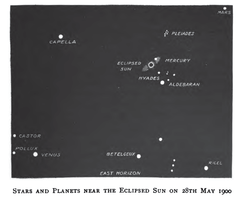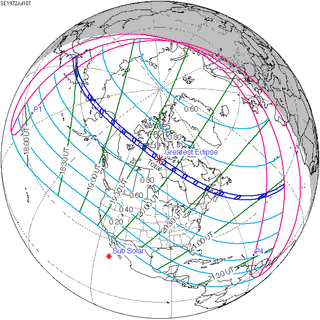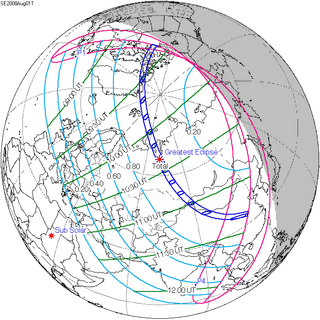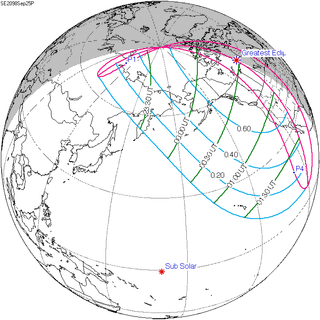Solar eclipse of May 28, 1900
| Solar eclipse of May 28, 1900 | |
|---|---|
|
Totality photographed in Wadesboro, North Carolina, by Thomas Smillie for the Smithsonian Solar Eclipse Expedition to capture photographic proof of the solar corona | |
 Map | |
| Type of eclipse | |
| Nature | Total |
| Gamma | 0.3943 |
| Magnitude | 1.0249 |
| Maximum eclipse | |
| Duration | 130 sec (2 m 10 s) |
| Coordinates | 44°48′N 46°30′W / 44.8°N 46.5°W |
| Max. width of band | 92 km (57 mi) |
| Times (UTC) | |
| Greatest eclipse | 14:53:56 |
| References | |
| Saros | 126 (41 of 72) |
| Catalog # (SE5000) | 9281 |
A total solar eclipse occurred on May 28, 1900. A solar eclipse occurs when the Moon passes between Earth and the Sun, thereby totally or partly obscuring the image of the Sun for a viewer on Earth. A total solar eclipse occurs when the Moon's apparent diameter is larger than the Sun's, blocking all direct sunlight, turning day into darkness. Totality occurs in a narrow path across Earth's surface, with the partial solar eclipse visible over a surrounding region thousands of kilometres wide.
Viewing
In 1900 the Smithsonian Astrophysical Observatory, then based in Washington, D.C., loaded several railroad cars with scientific equipment and headed to Wadesboro, North Carolina. Scientists had determined that this small town would be the best location in North America for viewing an expected total solar eclipse, and the Smithsonian Solar Eclipse Expedition hoped to capture photographic proof of the solar corona during the event for further study. The team included Smithsonian photographer Thomas Smillie, who headed up the missions photographic component. Smillie rigged cameras to seven telescopes and successfully made eight glass-plate negatives, ranging in size from eleven by fourteen inches to thirty by thirty inches. At the time, Smillie's work was considered an amazing photographic and scientific achievement.
 A map from 1900 |
 The stars during total eclipse |
Related eclipses
Saros 126
It is a part of Saros cycle 126, repeating every 18 years, 11 days, containing 71 events. The series started with partial solar eclipse on March 10, 1179. It contains annular eclipses from June 4, 1323 through April 4, 1810 and hybrid eclipses from April 14, 1828 through May 6, 1864. It contains total eclipses from May 17, 1882 through August 23, 2044. The series ends at member 72 as a partial eclipse on May 3, 2459. The longest duration of central eclipse (annular or total) was 5 minutes, 46 seconds of annularity on November 22, 1593. The longest duration of totality was 2 minutes, 36 seconds on July 10, 1972.[1]
Series members 39-49 occur between 1901 and 2100:
| 39 | 40 | 41 |
|---|---|---|
 June 8, 1918 |
 June 19, 1936 |
 June 30, 1954 |
| 42 | 43 | 44 |
 July 10, 1972 |
 July 22, 1990 |
 August 1, 2008 |
| 45 | 46 | 47 |
 August 12, 2026 |
 August 23, 2044 |
 September 3, 2062 |
| 48 | 49 | |
 September 13, 2080 |
 September 25, 2098 |
Notes
- ↑ Solar_Saros_series_126, accessed October 2010
References
- NASA graphic
- Fotos and sketchs of Solar Corona May 28, 1900
- The Total Solar Eclipse, 1900 Report of the expeditions organized by the British Astronomical Association to observe the total solar eclipse of 1900, May 28, A Publication of the British Astronomical Association, Chapter VII: "Elche" (Spain), by Mr. E. W. Johnson
- Total Eclipses of the Sun, By Mabel Loomis Todd, 1894, new and revised edition by David Peck Todd, 1900.
- Lewis E. Jewell et al. "Reports concerning the total solar eclipse of May 28, 1900 and of May 17, 1901”, Publications of the U.S. Naval Observatory 4 (1906) app.1, 94-97, 121-151, 203-215, 299-307 and pl. LXXII.
- Russia expedition for solar eclipse of May 28, 1900
| Wikimedia Commons has media related to Solar eclipse of 1900 May 2. |
.jpg)

